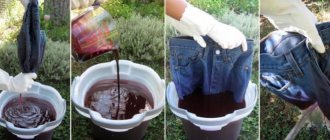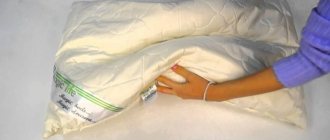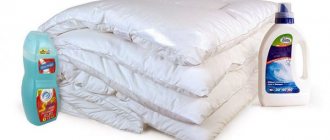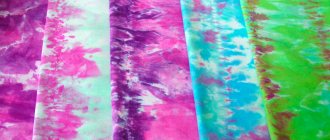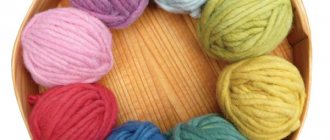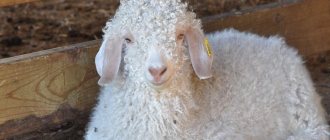Dyeing wool and down
If you have a need to dye woolen clothing or other wool or yarn products, the following tips will help you.
Attention . The most natural color of wool is the color of the wool itself; all methods of dyeing or bleaching, especially chemical ones, somehow harm the wool. Boiling and dyeing tangles the fibers making them stiffer and more brittle. This is important if you want to dye, for example, a down scarf. Naturally, painting with natural dyes is more preferable. If you're dyeing wool for the first time, be sure to try on a small piece first.
Products made from natural goat fluff have long been dyed using natural dyes, using decoctions of herbs, berries, tree bark and other plant components. Listed below are a variety of plants that provide their own color. All dyes produce one or another shade of paint depending on the amount of dye in relation to the amount of wool. Those. The more dye there is, the brighter the color will be. The combination of different colors gives different shades. You can experiment endlessly. The color of the coat you get can be seen by the color of the water before adding the wool (the color of the coat will be lighter than the color of the water). You can remove the wool from the solution until the end of the procedure if you think that the saturation is enough for you. If the water has not become discolored after removing the wool, you can only dye it in a lighter shade. Before dyeing a large amount of wool, a down scarf or a woolen product, be sure to conduct an experiment, for example, on a small amount of wool.
Red – buckthorn (wolfberry): young leaves and branches are used before flowering; – elderberry: ripe berries are used; – oregano: the herb used.
Yellow – birch: bark (yellowish tint) and leaves (bright color) are used; – wormwood: grass is used (the color comes out straw); – poplar: buds are used; – nettle: roots are used; – buckthorn: fresh bark is used (dried bark gives a brown tint); – orange or lemon peel; – carrots, turmeric (ground) and cumin (jeera).
Brown – oak: leaves and bark of the tree are used; – mosses and lichens growing on stones; – dried buckthorn bark; – horse sorrel root dug up in the fall; – basma; - strong coffee.
An orange-pink color will be obtained by mixing carrots, orange peel and one tablespoon of cinnamon.
For a delicate brick red color, beets are useful, and for dark purple, red onion peels.
Blue – blackberries; – blueberries; – meadow sage: grass is used; – Ivan da Marya (flowers); – quinoa seeds; – red cabbage.
Green – elderberry leaves; – sorrel leaves; – juniper berries; – inner bark of bird cherry and poplar; – spinach (you can add ground turmeric to it).
Gray - periwinkle: grass is used (the color is dark gray); – spruce bark; – bearberry leaves (light gray color)
Black color will come from maple leaves.
Orange – wild apple bark; – leaves and stems of celandine.
Golden brown – dry onion skins; – henna; – black tea (infusion).
Dyeing wool with natural dyes
Wool dyed with natural dyes does not lose its properties, and the color is bright and durable. In order to get a good coloring solution, you need to try a little: it is boiled several times. The colored water is poured into a container where the product will be painted, and the remaining raw materials are again filled with water and boiled - and so on until all the color is boiled off.
To dye the wool, it is necessary to boil it in the prepared solution over low heat for one to two hours, stirring constantly. Do not keep wool on the fire for too long, otherwise the fibers may become tangled and coarser. When the wool reaches the desired color, remove the container from the heat and let cool. Then you need to wash the product or yarn until it stops being dyed - and then dry it in the fresh air.
In order to achieve a more saturated color and further consolidate the shade, you can add a mordant to the solution during the dyeing process. Mordants are special substances that enhance the durability of dye on wool. Thanks to mordants, wool fibers become less sensitive to light and moisture.
Mordants can be natural or chemical. The first include tea leaves, mosses, and acorns (these components contain a small amount of alum). For etching with natural substances, a solution is prepared: per 100 grams of wool, take 50-100 grams of the desired plant and boil over low heat under a lid for about 45 minutes. After the solution has cooled, the wool is immersed in it. Over low heat, the liquid is heated, but not brought to a boil, for another 45 minutes.
Chemical mordants are alum (an absolutely safe substance that can be bought in pharmacies), cream of tartar (which can be found in supermarkets) - a white powder obtained from grape acid after fermentation, copper sulfate (copper sulfate) and ferrous sulfate (ferrous sulfate) – sold in stores for summer residents, acetic acid. For chemical mordanting, the wool or dyed item is removed from the solution, where the mordant is added, and then dipped back into the solution. It is very important during the pickling process to constantly stir the wool and turn it over in the solution - this will help avoid stains.
Chemical dyeing of wool
Chemical dyes – aniline dyes – are also used to dye wool and products made from it. The method for preparing the solution and dyeing wool is indicated on the packaging of the substance. You need to remember a few important rules that will help you in coloring. Pay attention to the container in which you are going to dye the wool: it should be voluminous so that the product or skein of wool lies freely there. It is best to choose an enamel container. Before dyeing, it is important to wet the wool thoroughly, and it should be completely immersed in the dyeing solution so that even a small corner does not rise above the surface of the solution.
The solution is prepared as follows. The powder from the bag is dissolved in half a liter of boiling water, stirred well and allowed to settle and cool for a while. After this, you need to strain the mixture through 2-3 layers of gauze and pour it into a container for coloring (the water temperature should not be higher than room temperature). Immerse six in the resulting solution and bring it to a boil. The entire procedure - from the moment the product is immersed in the dye solution until the end of painting - should not take more than 40 minutes. Wool or your woolen product must be constantly stirred in the solution, as it will float to the top. Wool absorbs the dye and the water in which the product or skein of wool is located will gradually begin to lighten - this is a sure sign that the dyeing process is going correctly. To speed up the process, you can add a little vinegar to the water (for example, to dye 500 grams of wool, half a glass of vinegar is used in half a bucket of solution). One part of the vinegar should be poured in at the beginning of coloring, the second at the end. If you dye wool in light colors, add vinegar only 25 minutes after the solution boils. Remove the wool, dyed in the desired shade, from the solution, let it drain thoroughly and cool. Then you need to rinse it thoroughly in several waters, adding vinegar to the last one.
How to dye wool; how to dye wool in boots
Any methods of changing color, either natural or chemical dyes, deteriorate the quality of the fiber. When boiled, it becomes hard, brittle and matted. If you cannot do without the procedure, give preference to natural dyes.
To achieve good results, follow the recommendations:
- First, always try the dye composition on a small and inconspicuous piece of fabric;
- if you are performing the operation for the first time, do not experiment - give preference to single-color staining;
- to get a brighter color, increase the amount of dye;
- to fix the shade and add brightness, add a little mordant to the composition;
- After the procedure, comb the coat using a carder or a dog brush.
Natural dyes can be used to obtain different colors. Thus, the red shade is given by elderberry and wolfberry, green by spinach and juniper, blue by blueberries and blackberries, brick by onion skins, brown by basma, yellow by wormwood and nettle. By experimenting with these substances, you can get interesting and unusual color solutions.
If you are using a natural remedy, prepare a solution. Place the coloring product you are using in water, bring to a boil and wait for it to color. Drain the liquid into the container where the procedure will take place and put the saucepan back on the fire. Repeat this operation until the water is completely discolored.
Place the wool in the prepared solution and place on low heat for 1.5-2 hours. Wait until the product acquires the desired shade, remove it and let cool.
Cold fiber should be rinsed with running water until it stops releasing excess dye, and dried naturally away from heating devices and sunlight.
Using the given algorithm, you can easily figure out how to dye wool in boots, change the color of yarn or material for felting. Remember: thermal exposure negatively affects the quality of wool, so do not use the procedure unnecessarily.
www.wday.ru
LiveInternetLiveInternet
—Categories
- I did it! :) (38)
- Garden Garden. (22)
- beauty and health (18)
- Let's improve your vision! (2)
- Poems and quotes (17)
- Psychology (14)
- Photography (12)
- Cities (12)
- A collection of ideas (10)
- crazy vul (9)
- diets (9)
- Dukan Diet (7)
- recipes for weight loss! (2)
- embroidery (8)
- cats kittens (7)
- From paper (6)
- audiobooks (5)
- Interior (5)
- interior accessories (2)
- Let's draw!! (5)
- Handicrafts workplace (3)
- beanie hats (2)
- English (2)
- washing, cleaning (2)
- Flower science (1)
- Equipment, fixtures, etc. (1)
- sewing2 (1)
- Fimo and polymer clays (1)
- Felting goods store (1)
- Beads, beads, tinsel. (message series) (28)
- felting (225)
- wet felting (59)
- we paint, repaint and touch up. (34)
- master classes links (21)
- dry felting. Toys (15)
- Felted flowers (14)
- bags (13)
- Felted shoes (12)
- wool paintings (12)
- felting masters (10)
- Scarves, stoles (8)
- materials science (6)
- everything for the Li.ru diary (8)
- knitting (302)
- knitted things (51)
- coats, jackets, cardigans (48)
- sweaters (37)
- socks, slippers (37)
- Irish lace (24)
- Beautiful patterns (16)
- technology tips (16)
- dresses (16)
- more knitted things (10)
- Tunics (5)
- Continuous knitting (3)
- DOLL fashion (2)
- children's (2)
- computer (25)
- photoshop (18)
- cooking (146)
- chicken dishes (21)
- decorations (13)
- blanks (11)
- salads (9)
- savory pastries (9)
- sauces and seasonings (7)
- sweet pastries (7)
- Lard, brisket, sausages, etc. (7)
- cookies (7)
- meat (6)
- vegetable dishes (6)
- fish!! (5)
- desserts (4)
- in the microwave (3)
- National dishes (2)
- quick meals (2)
- drinks (2)
- in a slow cooker (1)
- cakes (16)
- my toys (5)
- music (9)
- useful (41)
- funny (3)
- fabric + knitting (24)
- sewing (54)
- alterations (17)
- curtains (2)
- this is interesting (21)
- how to tie a scarf (3)
-Music
—Search by diary
—Subscription by e-mail
—Interests
— Regular readers
—Communities
—Broadcasts
-Statistics
Yarn dyeing with natural dyes
Yarn dyeing with natural dyes
Yarn dyeing with natural dyes
You are here » Home / Knitting materials / Dyeing yarn with natural dyes How to dye yarn with natural dyes To dye yarn, you can use natural means.
For example, it is easy to prepare yellow and beige dyes from birch leaves, yellow dyes from onion peels, and various shades of brown from spruce cones.
You can dye the yarn with oak bark the same color.
Excellent results, especially with tonal coloring, are obtained by using plants such as mignonette, buckthorn, chamomile, tea, poplar buds, birch bark, bird cherry, alder, barberry root, and thyme flowers. The basic conditions and rules for coloring are the same as when using chemical dyes.
The difference lies only in the methods of preparing dye solutions and in the additional, in this case, mandatory operations of preparing mordant solutions and pickling yarn. Take soft water for solutions: pre-heaven water or softened with soda ash.
Preparation of dyeing solutions for yarn. Dyes can be obtained from the branches, leaves, fruits, peel, bark and roots of plants. Both fresh and dried plants are used. When dyed with fresh plants, the colors are brighter and more intense, but usually less lightfast.
The shade of the dye also depends on the time the plants were collected. Collect leaves on June 7-10 (young leaves give more intense shades), flowers - just opened, bark - in the spring, when it is easily separated, roots - either before flowering or in the fall. Leaves, stems, roots, flowers, fruits, cones and bark are pre-soaked in soft cold water for 12 hours. For every 100 g of herb, take approximately 1 liter of water.
After this, bring the plants to a boil in the same water and keep on low heat (“simmer”), but do not boil. Simmer flowers and herbs for 30 minutes, bark, stems, nut shells, roots for 2-4 hours. It is not recommended to extract dyes from plants for longer, as the color of the infusion will become browner.
After this, pour the decoction into another container, straining it, and fill the plants with water again to get the 2nd decoction. “Simmer” the herbs and bark for about 30 minutes. Strain the 2nd decoction into the same bowl as the 1st.
Then prepare the so-called dye bath, that is, add the required amount of softened water to the resulting broth at the rate of about 4 liters of dye solution per 100 g of yarn. Preparation of mordant solutions. Dyeing yarn with vegetable dyes is impossible without treating the fibers with metal salts, which is called pickling. The following are used as mordants: potassium alum, iron sulfate (oxide and ferrous), copper sulfate, zinc sulfate, potassium chromium alum, chromium (sodium or potassium), tin dichloride.
Make a mordant solution at the rate of 10 g per 1 liter of water (1%).
Carry out etching with a large amount of solution: per 100 g of yarn - 3 liters of solution. First, dissolve 30 g of metal salt in a small amount of hot water (60°C), strain, pour into a container for dyeing, then increase the volume of the solution to 3 liters. It is not recommended to wring the yarn during or after pickling, otherwise the coloring will be uneven. There are also natural mordants, for example natural formic acid, sauerkraut brine, salt, vinegar, birch ash.
Pre-treating the yarn. Prepare a 1% mordant solution, dip clean, wet yarn into it and keep it at 60°C for 25 minutes. Then remove it from the solution, let it drain, transfer it to the dye broth and “simmer” for 30 minutes at 90°C. Simultaneous etching. Pour the prepared mordant solution into the dye broth, dip clean, wet yarn into it and “simmer” for 30-40 minutes at 60°C.
Subsequent yarn pickling. First, “simmer” the yarn in the dye solution for 30 minutes, then transfer it to the mordant solution and soak for 25 minutes at 60°C. Different methods of pickling have an effect on the color of the honey fungus - with preliminary pickling, the pickling of the yarn turns out to be darker and more intense.
Dyed yarn can be rinsed immediately after dyeing, or you can leave it in the solution until completely cooled and then rinse in warm water with the addition of a small amount of table vinegar (1 tablespoon per 10 liters of water). Then wring out the yarn and hang it on a stick to dry.
When yarn is dyed with plants, the protein fibers of silk and wool are dyed more intensely, while those of cotton and linen are dyed weaker. When dyeing cotton and linen, make more concentrated dye solutions or repeat dyeing several times.
By experimenting with solutions of different saturations and different mordants, you can get a wide variety of shades.
The following are painted yellow: barberry (bark, roots, wood), birch (leaves and young bark), cornflower (stems and leaves), heather, wolfberry (bark), pomegranate (crusts), oak (bark, acorns), spruce ( cones), nettle, buckthorn (bark, fresh branches), linden (fallen leaves), onion (husk), dandelion, walnut (shell), tansy, wormwood, rhubarb (roots), chamomile (flowers), bearberry, yarrow, tea, series
The following are painted green: wild rosemary, elderberry, heather (leaves and berries), St. John's wort, nettle, juniper (berries), tansy (leaves), horsetail (stems), rowan (bark), poplar (bark, branches, leaves), bird cherry (bark, branches), sorrel (leaves). The following colors are painted blue: basma, woad (leaves), cornflower (petals), buckwheat (leaves), blackberries (berries), litmusgrass, clubmoss (stems), blueberries (berries), sage (stems, leaves).
Let's start painting
1. Prepare the workplace. Cover the table with a two-centimeter layer of newspaper. Cover all nearby objects that are not planned for painting with newspapers. Plastic bags will be needed to cover the table on top of the newspapers. Painting will be carried out on plastic film, in addition, subsequently the wool will need to be wrapped in it.
2. The wool is soaked for ten minutes in warm water. At this time, you need to dilute the powder dyes. To do this, pour warm water into a disposable container, add dye and stir it thoroughly using a disposable plastic spoon.
3. Add dye powder in the volume depending on what color of wool you want to achieve. To obtain a darker color, add more coloring pigment. To start, you can try taking 0.5 teaspoon of each color. Using a funnel, pour the dye diluted in warm water into a spray bottle. You need to add table vinegar to the spray bottle - about half a cup. Don't worry about what all the components are - the exact proportions aren't important here. If the output turns out to be very little coloring liquid or its color is too saturated, add some warm water. You can close the spray bottle and thus dissolve the paint in it, or you can simply stir the contents of the spray bottle with a stick. Dilute the remaining paints in the same way.
4. Take the wool out of the basin, squeeze out excess water from it, straighten it and place it, avoiding gaps, like a snake. Spread the wool on the work surface you have prepared in advance. Spray the paint over the entire surface of the wool. Dyes need to be sprayed until the wool is completely saturated with them. Don't be alarmed if you see a small puddle of color under the fur - there's nothing to worry about.
6. Of course, by rolling this bag, you provoke the spilling of dyes from the wool. However, if your workplace was equipped in accordance with the above recommendations, then all excess coloring liquid will be absorbed into a thick layer of newspapers.
7. Place the roll of wool in a colander, and, accordingly, place the colander on a pan of boiling water. The wool should be steamed for about 20 minutes with the lid closed. After 20 minutes, turn off the stove, the wool should cool down. Next, the now cooled wool should be rinsed in warm water until the water becomes clear and colorless.
When working with woolen materials, needlewomen and craftswomen often have a question: how to dye yarn or felt? Other people have situations where their favorite woolen item has faded or lost color after numerous washes, but has not lost its other external qualities. In such cases, there is a way out - choose a special dye and tint the wool. Read on to learn how to do this at home.
The first question that arises before painting is: which dye to choose? There are many options among both folk and modern chemical remedies. Due to its natural origin, almost any dye shows up best on wool.
.
Using natural dyes you can give the yarn a beautiful shade. In addition, it will not lose its properties and will remain just as soft and warm. Using herbs, vegetables and fruits, you can paint a thing in the following colors:
- brown (oak bark, strong coffee, basma);
- golden (strongly brewed tea, onion peel, henna);
- red (elderberry);
- green (spinach, sorrel or elderberry leaves);
- yellow (poplar buds, lemon zest, orange zest, carrots, turmeric);
- blue or purple (blueberries, red cabbage);
- orange (celandine leaves).
In order to dye fabric or yarn using these natural ingredients, you need to thoroughly boil them in boiling water so that they give out their color as much as possible.
Important! For a rich color, it is better to additionally use special substances when boiling - mordants. They will enhance the durability of the paint and fix it to the wool. These products include moss, acorn, and chemical alum.
Special aniline dyes are used as a chemical dye .
It is usually sold in powder form in different colors. Using it you can prepare a special solution for painting. All proportions are indicated on the product packaging.
How to start dyeing yarn (+photo of yarn)
I succumbed to the general fashion for dyeing yarn. I didn’t consider food dyes, I won’t even go into details. I decided that I would start with chemical ones. I chose a couple of options and decided to start by choosing those that were at hand. I went to a craft store and they only had this dye. I took the basic colors and immediately painted them at home.
Dye in a small portion packet in powder form: powder can be sprinkled onto the yarn for a speckled effect and stirred in the desired proportions for color intensity.
I liked my painting experiment, but it requires a lot of time, attention and requires careful preparation. On your hands - gloves (preferably thicker ones; the ones included are quite flimsy); preferably a face mask. Special dishes, towels and other auxiliary materials are also required.
I recommend purchasing one color of this dye. Use them all and decide: do you want to continue doing this or is it not for you. If yes, then feel free to order German or American dyes: this is a different level of yarn coloring and, in my opinion, higher. And, of course, in this case, the raw materials for painting also need to be chosen with better quality.
Thanks for your attention and great experiments

